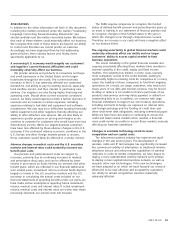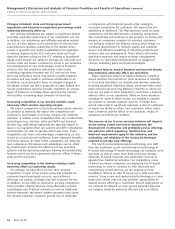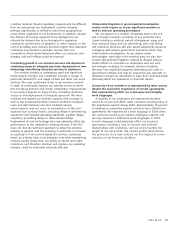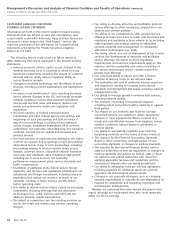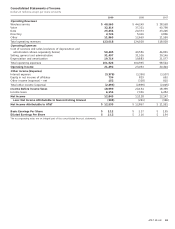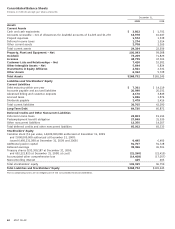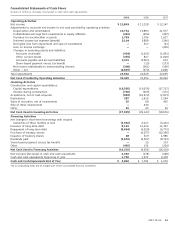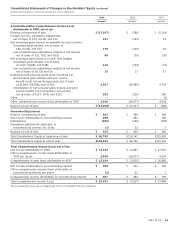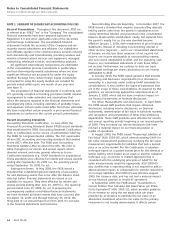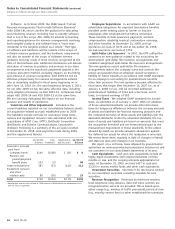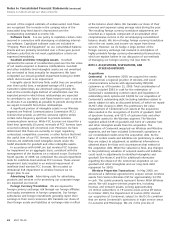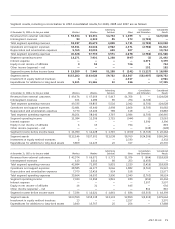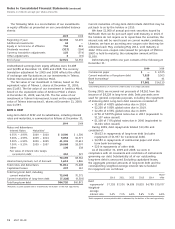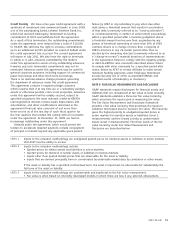AT&T Wireless 2009 Annual Report Download - page 67
Download and view the complete annual report
Please find page 67 of the 2009 AT&T Wireless annual report below. You can navigate through the pages in the report by either clicking on the pages listed below, or by using the keyword search tool below to find specific information within the annual report.
AT&T 09 AR 65
disclosures. We adopted the new guidance for the year ended
December 31, 2009. This guidance significantly increased the
amount of annual disclosures for plan assets in our annual
report, and it will increase our future interim disclosures in
that regard (see Note 11).
Business Combinations In December 2007, the FASB
amended GAAP for acquisitions, requiring that costs incurred
to effect the acquisition (i.e., acquisition-related costs) be
recognized separately from the acquisition. Under prior
guidance, restructuring costs that the acquirer expected but
was not obligated to incur, which included changes to benefit
plans, were recognized as if they were a liability assumed at
the acquisition date. Amended GAAP for acquisitions requires
the acquirer to recognize those costs separately from the
business combination. We adopted the new guidance as of
January 1, 2009, and applied it to acquisitions consummated
after 2008, including the Centennial Communications, Corp.
(Centennial) acquisition, as discussed in Note 2.
Equity Method Investments Accounting In November
2008, the Emerging Issues Task Force (EITF) reached a
consensus on new clarification guidance regarding the
application of the equity method. It states equity method
investments should be recognized using a cost accumulation
model. It also requires that equity method investments as
a whole be assessed for other-than-temporary impairment
in accordance with existing GAAP for equity method
investments. The new guidance was effective, on a
prospective basis, for initial or additional equity method
investments transactions and subsequent impairments
recognized in interim and annual periods that began on or
after December 15, 2008 (i.e., as of January 1, 2009, for us).
The new guidance did not have a material impact on our
financial position or results of operations.
Revenue Arrangements with Multiple Deliverables In
October 2009, the FASB issued “Multiple-Deliverable Revenue
Arrangements” (ASU 2009-13), which addresses how revenues
should be allocated among all products and services included
in our sales arrangements. It establishes a selling price
hierarchy for determining the selling price of each product
or service, with vendor-specific objective evidence (VSOE)
at the highest level, third-party evidence of VSOE at the
intermediate level, and a best estimate at the lowest level.
It replaces “fair value” with “selling price” in revenue
allocation guidance, eliminates the residual method as an
acceptable allocation method, and requires the use of the
relative selling price method as the basis for allocation.
It also significantly expands the disclosure requirements for
such arrangements, including, potentially, certain qualitative
disclosures. ASU 2009-13 will be effective prospectively
for sales entered into or materially modified in fiscal years
beginning on or after June 15, 2010 (i.e., the year beginning
January 1, 2011, for us). The FASB permits early adoption
of ASU 2009-13, applied retrospectively, to the beginning of
the year of adoption. We are currently evaluating the impact
on our financial position and results of operations.
investments that are required or permitted by GAAP to be
measured or disclosed at fair value on a recurring or
nonrecurring basis. It requires disclosures by major category
of investment about certain attributes (e.g., applicable
redemption restrictions, unfunded commitments to the issuer
of the investments, and the investment strategies of that
issuer). ASU 2009-12 was effective for interim and annual
periods ending on or after December 15, 2009 (i.e., the year
ended December 31, 2009, for us). See Note 11 for the
impact of our adoption of ASU 2009-12.
In January 2010, the FASB issued “Fair Value Measurements
and Disclosures—Improving Disclosures about Fair Value
Measurements” (ASU 2010-06), which requires new
disclosures and reasons for transfers of financial assets and
liabilities between Levels 1 and 2. ASU 2010-06 also clarifies
that fair value measurement disclosures are required for each
class of financial asset and liability, which may be a subset of
a caption in the consolidated balance sheets, and those
disclosures should include a discussion of inputs and valuation
techniques. It further clarifies that the reconciliation of Level 3
measurements should separately present purchases, sales,
issuances, and settlements instead of netting these changes.
With respect to matters other than Level 3 measurements,
ASU 2010-06 is effective for fiscal years and interim periods
beginning on or after December 15, 2009 (i.e., the quarter
ending March 31, 2010, for us). New guidance related to
Level 3 measurements is effective for fiscal years and interim
periods beginning on or after December 15, 2010 (i.e., the
quarter ending March 31, 2011, for us). We are currently
evaluating the impact of ASU 2010-06 on our disclosures.
See Note 9 for fair value measurements and disclosures
for our investment securities and derivatives.
Derivative Instruments and Hedging Activities Disclosures
In March 2008, the FASB amended the disclosure
requirements for derivative instruments and hedging activities.
The new guidance requires enhanced disclosures about an
entity’s derivative and hedging activities to improve the
transparency of financial reporting. We adopted the new
guidance as of January 1, 2009, which increased our
quarterly and annual disclosures but did not have an impact
on our financial position and results of operations. See
Note 9 for a comprehensive discussion of our derivatives
and hedging activities, including the underlying risks that
we are managing as a company, and the new disclosure
requirements under GAAP.
Pension and Other Postretirement Benefits In
December 2008, the FASB issued a staff position that
amended an employer’s disclosure requirements for pensions
and other postretirement benefits. The new guidance replaced
the requirement to disclose the percentage of fair value
of total plan assets with a requirement to disclose the fair
value of each major asset category. It also amended GAAP
standards for fair value measurements to clarify that defined
benefit pension or other postretirement plan assets were
not subject to other prevailing GAAP standards for fair value


